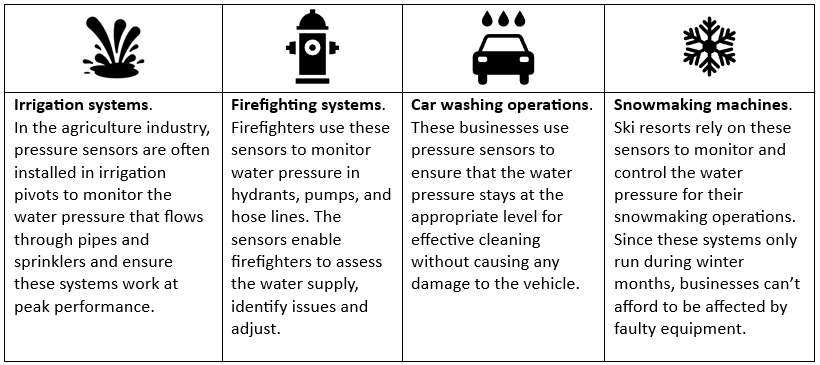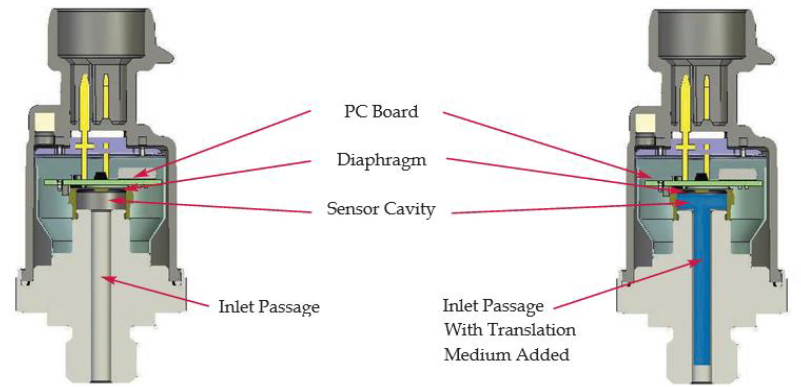
By:
Todd McPadden
Product Sales Leader, High Pressure Transducers
Published on:
January 16th, 2024
Subscribe now and get the latest blog posts delivered straight to your inbox.
Can a pressure transducer get damaged by freezing water?

By:
Todd McPadden
Product Sales Leader, High Pressure Transducers
Published on:
January 16th, 2024

Freezing temperatures can damage sensitive electronic pressure-measuring instrumentation, such as a pressure transducer/transmitter. Regardless of whether an operator tries their best to remove all the water from their system to prevent freezing, it is still possible that a small diaphragm cavity or pressure passage within the transducer's sensor will retain water.
When this water freezes, it can cause excessive pressure on the sensor diaphragm element, exceeding its normal range of motion, and resulting in permanent distortion. Even when the ice melts with warmer temperatures, the transducer will no longer be able to return to its original zero position, making it unusable and necessitating replacement.
Ashcroft, a leading manufacturer of pressure and temperature instruments since 1852, has explored this challenge extensively and offers a solution to help you prevent this from happening in your water-based applications. In this article, we will discuss what exactly happens to pressure-sensing instruments when they are exposed to freezing temperatures, the common applications where this occurs and a cost-saving solution for protecting your instruments and keeping your operation running effectively.
Common applications where pressure sensors can be affected by freezing conditions.
Virtually any water distribution system that uses transducers/transmitters to monitor water pressure in environments with freezing temperatures is at risk for instrument damage that can cause your operation to fail. A few examples include:
Figure 1: Examples of water-based applications using transducers.

In any of these applications, pressure-sensing devices can be rendered inoperable in freezing temperatures, and ineffective even after thawing. Without a functioning pressure sensor, there is a risk of the system not functioning as needed or even worse not working at all.
What happens when water freezes in your system?
First, it is important to remember that water begins to freeze when the temperature reaches 32 °F or 0 °C. If the temperature remains below freezing for a prolonged period - or if the temperature continues to fall, the expansion of the ice will cause the pipes in the system to physically burst and the sensors to become ineffective.
Here’s why:
• When water freezes, the volume of ice can increase significantly under atmospheric pressure.
• Initially, the expansion will reach about 9%.
• The increase in pressure in the system will reduce the freezing point.
• If the melting (or freezing) point is lowered by large increases in pressure, the increase in volume on freezing is even greater.
When exposed to these conditions, the sensor you use to measure water pressure can damage the sensor diaphragm. The diaphragm will over-deflect, exceeding its normal range of motion, resulting in permanent distortion, or even rupturing.
To learn about common mistakes people make when selecting pressure sensors, download our guide. 
Factors that contribute to temperature changes in a system.
There are a variety of factors that determine when residual water in a particular system will freeze. Here are just a few:
1. The ambient temperature at the water pipes is below freezing.
This means that the temperature surrounding the water distribution system (i.e., pipes) is below the freezing point of water (0°C or 32 °F).
2. The exposure conditions of the piping.
This refers to all conditions to which the system is exposed, including below-freezing temperatures, effects of drafts, wind and leaks that blow freezing air in or around the system. This cold-air movement will push more heat away from the exposed area than still air.
3. The presence or absence of insulation on water pipes.
Insulation on water distribution systems may offer a short-term freeze protection solution for drops in temperature. However, this protection may eventually be lost when the temperature drops below freezing for an extended period.
How can I protect my transducer/transmitter from freezing?
To address the issue of pressure sensors failing after freezing, Ashcroft® engineers developed a unique solution that was applied to the G2 Pressure Transducer, the T2 Pressure Transducer and the S1 OEM Pressure Transducers. The modification involves a stable, emulsified lubricant that is injected into the diaphragm cavity and most of the inlet passage.
Figure 2: Transducer diagram.

This viscous material displaces air and seals the cavity to prevent water from contacting the diaphragm and settling in the cavity. Once injected, the emulsion adheres to the inner walls of the sensor and forms a thin skin inside the inlet passage, preventing it from leaking out of the sensor, even when the transducer is mounted in the upright position.
As water pressure is introduced into the system, the emulsion serves as a translation medium, exerting a force upon the diaphragm equal to the force exerted upon it by the pressurized water. The addition of the translation medium may cause a slight deviation from the transducer’s advertised specifications for accuracy and response time. However, in most applications, this variance may be regarded as insignificant.
Do you want to learn more about pressure sensor performance in different applications?
Transducers and transmitters play an important role in the success and safety of your systems. The more you know about how the sensors work and what can affect their performance, the more prepared you will be to take the necessary steps to address challenges like freeze protection in the future.
Here are a few more related articles that may interest you:
• How Does Media Temperature Affect Pressure Transducer Performance?
• What Makes OEM Pressure Sensors Accurate and Repeatable?
Or, reach out today to talk to one of our industry experts and get all your pressure transducer questions answered.
In the meantime, download our guide to learn more about the Ashcroft® S1 Pressure Transducer. 
Todd McPadden, Product Sales Leader, High Pressure Transducers
Todd is the product manager for OEM High-Pressure Transducers with more than 19 years of experience at Ashcroft.

























